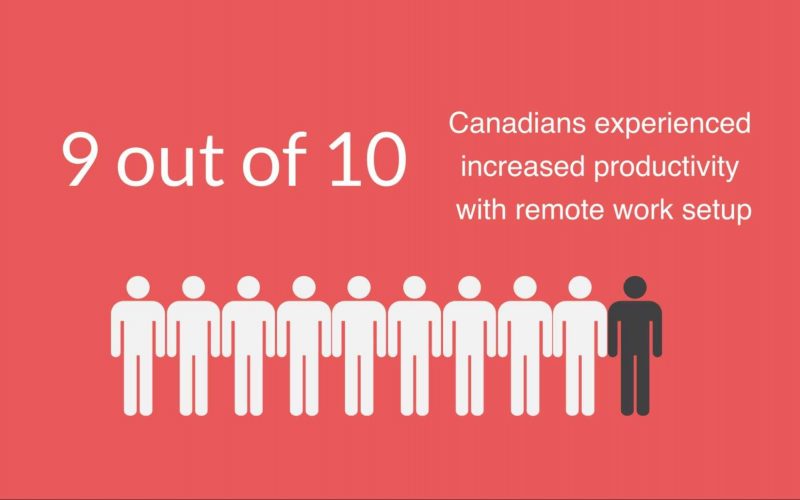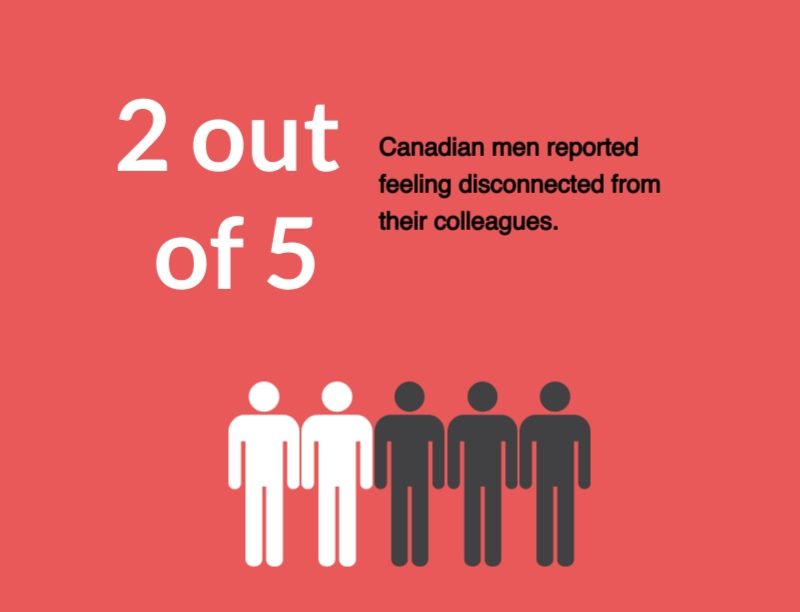How many people work remote in Canada
Due to COVID-19, approximately 30% of workers in Canada have worked remotely, and the trend is expected to continue. While there are obstacles to overcome when working from home, there are significant advantages, like higher productivity and an improved work-life balance.
Below, you’ll see fascinating statistics related to remote working to understand this growing trend better.
Editor’s Choice
|
Statistics Related To Remote Work In Canada
Working from home has become popular in Canada due to the COVID-19 pandemic. Here’s a quick look at the statistics on remote work in the country:
1. Roughly 30% of Canadians worked during the COVID lockdown.
(Statista)
In May 2021, around 5 million Canadians worked from home, about 30% of the total workers. This data is much more than before the pandemic, as only 4% of workers worked from home in 2016.
2. Over 78% of Canadian workers prefer working from home over their regular workplace.
(Benefits Canada, Environics Institute)
According to a survey involving over 6,600 employees, 78% agreed that after the coronavirus pandemic, their employer should continue to allow them to work from home at least a couple of days per week.
| ????Fun Fact:
Canada is a bilingual country. People don’t assume anything about others’ official language abilities. As Canada is also an immigration country, people around them may have various language abilities and accents. However, it’s never a problem with them. They believe communication is more important than perfect grammar. |
3. 70% of remote workers are well-educated.
(Policy Options)
Most Canadians working from home are well-educated knowledge workers in the sciences, government services, business and finance, education, law, social services, management, the arts, and culture.
| ????Fun Fact
Canada is one of the world’s most educated countries, with a 99% literacy rate. Employers prefer to recruit graduates from trade schools, universities, and colleges. Over 56% of the adult population also has a tertiary qualification. |
4. 80% of remote workers have high incomes.
(Policy Options)
Remote workers in Canada tend to have higher household incomes, with 81% reporting annual incomes above $160,000 and 82% identifying as “upper class.”
| ????Did you know?
IT has one of the fastest-growing careers in the country. Technology is ever-evolving, and Canada is well-established to invest in it by adopting emerging technologies like Artificial Intelligence, Analytics, Cloud services, etc. Regarding salary, entry-level positions start at $73,549 annually, while most experienced workers make up to $138,893. |
5. Workers in Canada can complete 40% of jobs from home.
(Statistics Canada)
According to estimates, approximately 40% of all Canadian jobs can be effectively performed from home, including some of the highest-paying jobs in the country. It’s worth noting that not all jobs are suitable for remote work.
Some jobs that can be easily completed remotely are:
- Customer Service Representative
- Software Developer
- Accountant/Bookkeeper
- Business Development Representatives
Positive Experiences of Working From Home
Working from home has allowed Canadian workers a better work-life balance, reduced commute times, and increased productivity. Check these statistics:
6. 80% of new remote workers prefer to work remotely at least half the time.
(Statistics Canada)
A report by Statistics Canada shows that 80% of new remote workers would like to spend at least half of their weekly work hours working from home if given the option. About 40% would prefer to work remotely for better work-life balance and increased productivity.
7. Over 70% of remote workers reported higher levels of satisfaction.
(Psychology Today)
70% to 83% of remote workers expressed very high satisfaction with various aspects of their work, such as:
- the level of respect they receive from colleagues
- their level of independence
- their way of doing their work
- job security
- work-life balance
- the meaning of their work
8. 9 out of 10 Canadians feel productive when working from home.
(Statista)
Due to fewer social interactions and distractions, many Canadian remote workers claim to be just as productive as in the office. Specifically, among the 90% who reported stable or improved rates, 41.2% noticed increased productivity.
 9. 64% of Canadian workers felt their work-life balance improved in 2021.
9. 64% of Canadian workers felt their work-life balance improved in 2021.
(Ipsos)
64% of working Canadians, including 15% strongly and 49% somewhat, achieved better work-life balance in 2021. Quebecers had the highest percentage at 77%, while Albertans had the lowest at 49%.
When you’re working remotely, your office becomes anywhere in the world.
| ????Did You Know?
Canada ranked 24th for work-life balance in a survey by The Organization for Economic Cooperation and Development. Although only 3% of Canadian employees work long hours, there is a big difference in the time devoted to personal care, such as sleeping, eating, and leisure. |
10. In 2021, 88% of workers reported enjoying spending time at home more frequently.
(Ipsos)
One of the best perks of work-from-home setup is greater flexibility. According to Ipsos, 88% of workers agreed they enjoyed spending time at home more often in 2021, while only 12 % disagreed.
 Negative Experiences Of Working From Home
Negative Experiences Of Working From Home
While remote work has brought numerous benefits, it’s also crucial to acknowledge its downsides. Take a look at some data below:
11. 1 out of 3 women said that their productivity at home was terrible.
(Angus Reid, Microsoft)
A survey by Angus Reid showed that 32% of women aged 18 to 34 felt their work productivity was challenging. On top of that, staying in front of your screen for too long may contribute to poor sleep quality, promoting burnout.
According to Microsoft’s recent study, 85% of leaders believe that:
| “…shift to hybrid work has made it challenging to have confidence that employees are being productive.” |
They also emphasize that 49% of managers of hybrid workers lack trust in worker productivity, leading to productivity paranoia.
| ????Did You Know?
Productivity paranoia refers to leaders’ fear of losing productivity due to employees not working, even though many activity metrics have increased. On the other hand, productivity theater is a state where employees feel pressured to show they’re working. |
12. 2 out of 5 Canadian men felt disconnected from colleagues.
(ADP Canada)

According to a survey conducted by ADP Canada in March 2021, 39% of Canadian men working from home due to the pandemic; reported feeling disconnected from their colleagues.
Even employees worldwide expect more than just good pay and benefits. They also want to feel a true sense of belonging and community. With this setup, employee engagement concerns have also heightened.
13. 45% of Canadians reported working longer hours.
(Environics Institute, SHRM)
According to a survey conducted by the Environics Institute, 45% of Canadians who have worked remotely agreed that they feel like they are always working for themselves or their family.
Robert Half’s Senior Executive Director, Paul McDonald, adds:
| “While remote work affords employees greater flexibility, it makes disconnecting extremely difficult. Many people [are pressured] to keep up with rising workloads and put in long hours to support the business and customer needs.” |
Other Fascinating Work-From-Home Related Statistics
The work-from-home setup is here to stay. If you plan on working remotely or hiring remote employees, doing your research first is essential.
Here are some fascinating work-from-home-related statistics:
14. Most remote workers are under 35.
(Forbes)
In spring 2022, workers under 35 (43%) were more likely to work from home at least a few days a week due to the pandemic than workers aged 55 and over (33%).
This means the younger workforce appreciates remote work’s flexibility and structure more than the older generations. However, it could affect businesses looking to attract and keep this talent group.
15. Approximately 1 in 3 people found a new job better suited for remote work.
(Environics Institute)
In early 2022, 31% of people who started working from home due to the pandemic reported switching jobs to find a more suitable one for remote work.
| “People will not return to work [as they did] in the past. Flexibility is the new norm and expectation from employees — we will see this trend continue in the months ahead.” – Kristin Kelley, CMO at CareerBuilder |
16. Only 4% of Canadian women and 3% of males were willing to work all hours outside their homes.
(Statista)
A study conducted among Canadians in 2022 suggests some employees desired to return to work from the office after the pandemic as they prefer personal interaction with colleagues. The rest of the workers chose to work more hours at home, and some to telework entirely
17. About 35% of individuals agree that working from home could negatively impact their careers.
(Environics Institute)
For individuals who continue to work from home during the pandemic, the experiences have been mostly positive, with negative experiences being less common but still reported by a significant minority. Around 35% of people worry about the negative impact of working from home on their careers.
| ????Helpful Article:
Here are side hustle ideas that can help you achieve your goal within a week or less, even if you do not have a regular day job: How to Make $1000 Fast? 19 Easy Ways to Make it Rain |
18. 84% of people in British Columbia and the Atlantic provinces preferred to work from home.
(Statista)
In 2022, most people in British Columbia and the Atlantic provinces favored remote work, while those who preferred on-site work were more common in Alberta.
19. Working from home reduces about 17 million metric tons of carbon emissions by eliminating commuting.
(Flexjobs)
Based on the study, if remote workers spend at least half their time working remotely, greenhouse gas emissions could be reduced by millions of metric tons annually. It’s like removing 3.7 million cars from the road.
Final Words
Working from home has grown in popularity among Canadians and is predicted to continue. While remote work has drawbacks, it frequently leads to higher productivity and a better work-life balance.
As the workplace evolves, it’s evident that remote work is here to stay, and those that embrace it will have a better chance of success.
FAQs on Remote Work Statistics in Canada
What is the remote work policy in Canada?
Employers are allowed to visit the worker’s remote location with a 48-hour notice to check whether it’s safe and hazard-free to maintain company-owned equipment and supplies.
What percentage of remote workers report a better sense of work-life balance?
In Real Simple’s survey, about 48% of poll respondents working from home claimed that remote work had improved their work-life balance.




